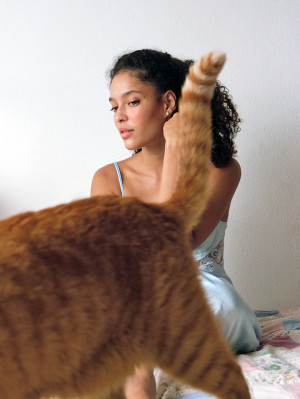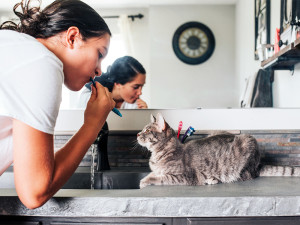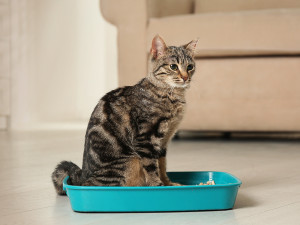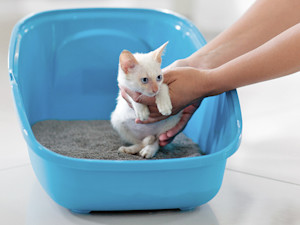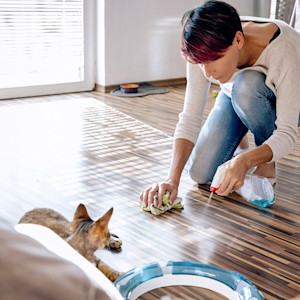Why Is Your Cat Peeing in the Bathtub?
This seems... like a weird choice.

Share Article
In This Article:
Cat pee may be the last thing you expect to find in your bathtub or shower. But at least you discovered it before you slipped in it, right? That would be hard to explain to the ER nurse. This is actually a more common issue than you think — the peeing, not the slipping.
Let’s talk about how to deter your cat from peeing in the tub or shower and why the heck they’re doing it in the first place.
How much do you spend on your pet per year?

Why do cats pee in the bathtub?
As a behaviorist, I consider the litter box the only appropriate place for our cats to pee. But cats don’t have the same relationship with the litter box that we do. They’ll often go looking for alternatives if something doesn’t feel right about that box. Some cats find their way to the bathtub.
If your cat is peeing outside the box, something is wrong. There’s a medical, emotional, or litter box setup issue that needs to be addressed. Time for some detective work! Getting to the bottom of the trigger is your first step in solving the problem.
Discomfort with litter box
These are just a few questions to consider when evaluating your cat’s litter box.
Is the litter box meeting your cat’s instinctual needs?
Has something changed, like the location or litter type?
Are you scooping daily?
Does your cat have physical discomfort or mobility issues that might make balancing on or digging in litter difficult?
Seeking privacy or quiet
You don’t want your cat’s litter box tucked away in a back room, at the opposite end of the home from their preferred hangout zones. But you also don’t want it in the middle of your home’s Grand Central Station.
If the box is too close to a busy kid’s play area, in front of the new surround sound speakers, or perhaps next to the puppy’s crate, your cat may feel exposed or anxious using it and head someplace a bit more private, like the bathtub. It's also important to make sure other pets aren’t stalking or bothering your cat when they’re using the litter box. If one option doesn’t feel safe, your cat may look for others that do.
Stress or anxiety
Stress is a huge trigger for soiling, whether that’s urinating or pooping in the bathtub, sink, or somewhere else. Any number of things can cause stress, like:
A new pet in the home
A new baby or adult in the home
Not getting along with another pet
Medical issues, pain, or discomfort
General fear or fear of a specific trigger
Preference for cool surfaces
Cats will occasionally seek out cold surfaces like bathtubs, sinks, and counters to pee on. One idea is that the cool surface feels more comfortable for a cat to squat on when they’re experiencing pain while urinating, such as pain from a urinary tract infection (UTI).
Territorial marking or scent spreading
Cats will pee (or spray) to deposit their scent. It can be a form of communication between cats, a way of marking their territory, or a self-soothing behavior. Your cat may feel they need their scent in the bathtub if they’ve fought with another pet in that area, there’s a strange cat outside the bathroom window, or there was another stressor in or around the bathroom.
Negative associations with the litter box
If your cat has a negative experience while using the litter box, they may avoid it and switch to the bathtub or another location. Things like being attacked, a loud sound scaring them, or even feeling pain when in the box can make your cat think it’s a bad place to be… or pee.
Lack of litter
Some medical issues cause discomfort just from standing or moving on litter. Cats with paw pain (often from cracked paw pads, paw/claw infections, or declawing) or those dealing with mobility issues (like arthritis) may have a hard time standing and balancing on the litter, especially if you’re using pellets or grain litter that has sharp edges.
The tub has the same “inside” feel as a litter box but without that pesky litter.
Could it be a health problem?
Yes. Medical issues are the first and most important consideration if your cat starts peeing or pooping in the tub, the shower, or anywhere other than the litter box. Your vet will look for issues related to the urinary tract, like:
UTI
Urinary crystals
Kidney disease
Incontinence (often due to age or neurological issues)
But it’s vitally important to know that any kind of pain or discomfort can lead to accidents. I’ve seen cats peeing in the bathtub and other areas due to paw pain, joint pain, ear infections, dental pain, broken bones, and more. Make sure your vet does a thorough exam to rule out pain from any source.
How to stop your cat from peeing in the bathtub
Identifying the cause of your cat’s bathtub soiling is essential to resolving the problem. If there’s no clear trigger, give these tactics a try. (They’re also good tips for cat care in general.)
Clean the bathtub thoroughly
Use a pet-safe, unscented disinfectant to clean the tub. Using something with a strong scent can actually encourage your cat to pee there in an effort to cover up that unappealing cleaner smell.
Provide alternate ways for scent marking
If your cat pees in the tub because they need their scent in that area, and you clean the tub, you’ve removed their scent. Your cat’s instinct will be to pee there again to replace it.
Give them other ways to leave their scent, like adding a litter box or scratcher in the bathroom. You can also rub your cat’s cheeks with a cloth. Then rub that cloth around the tub and bathroom daily for a couple of weeks and see if anything improves.
Address litter box issues
Just because they’ve been using the same litter box setup for years doesn’t mean it fits their instinctual needs well. It’s common for cats to change their willingness to use a less-than-ideal litter box quite suddenly. Consider making some adjustments to the box setup, even if they were using it just fine last week.
Add a new litter box
If your cat is choosing to pee in the tub, there’s a reason. Try giving them a better alternative. Add a litter box in the bathroom.
If you don’t need that tub, try a box right there in the tub. You might want to put tape over the faucet handle just to make sure no one accidentally turns the litter box into a litter boat. Litter down the drain is a bad idea.
If your cat uses the new box reliably, you can try gradually moving it to a better location. If they go right back to using the tub, you know there’s something about that spot that’s important.
Create a calm environment
Lowering stress is part of every behavior plan I write for house soiling. If you know of specific triggers or changes that increased your cat’s stress, try to eliminate or minimize them.
For triggers that can’t be removed, you can help your cat feel better about them. Try building lots of positive associations around the triggers by pairing them with treats and other things your cat loves. A certified feline training and behavior consultant can be really helpful in these situations to help identify and resolve triggers.
How to prevent your cat from peeing in the bathtub
Stopping your cat if they’re already peeing in the bathtub and preventing your cat from starting this behavior, go hand in hand. All of the tactics above can help with prevention, and the following prevention tactics are helpful when trying to stop the tub peeing.
Clean and maintain litter boxes
Do you like using a smelly, full port-a-potty? Your cat feels the same way about a dirty litter box. Scooping every day is vital. Make it easy on yourself by getting a litter waste system that lets you scoop and dump the litter clumps in a stink-proof, fully enclosed container that you only have to empty when it gets full.
Dump all your litter and clean the box once a month. Depending on the litter you use, your box may need more frequent deep cleaning. It might also be time to replace old plastic boxes. Odors and bacteria can settle into the scratches made by your cat’s claws.
Provide more litter box options
Here are two important rules:
Shoot for one more box than the number of cats. If one box is dirty, doesn’t feel safe, or is being used, your cat needs another option, or they may turn to the bathtub.
Spread your boxes around the home. Four litter boxes sitting side-by-side in the basement don’t feel like four separate litter box options to your cat. Spread them out. One on each floor, opposite ends of the home, etc.
Reduce stress and anxiety triggers
In addition to working on specific triggers, as discussed above, consider ways to reduce stress more generally. Play sessions, mental enrichment, bonding time, and making sure your cat’s resources meet their instinctual needs are huge stress reducers.
Monitor changes in routine or environment
The best way to identify potential medical or emotional issues is to watch for changes in your cat’s normal behavior. Have eating, drinking, or sleeping habits changed? Any changes in pee or poop color, smell, or consistency? Is your cat less affectionate with you and more aggressive with other pets?
These can all be signs of physical discomfort or stress. Catching signs early means you can evaluate their environment and check in with your vet to get to the bottom of the issue before things like bathtub peeing start.
When to seek professional help
If you’re not making progress on your own, you notice other signs of illness or pain, or you can’t get to the bottom of your cat’s anxiety, there are options! Your veterinarian’s advice is crucial in identifying potential medical causes, such as those mentioned above. A feline training and behavior consultant can help with litter box setup, as well as finding and addressing emotional triggers.
Bottom line
If your cat is peeing in your tub, there’s a reason for it.
It may feel safer than the litter box, they may need their scent in that area, or any number of other reasons.
It’s time for some detective work. Finding the trigger is key to resolving the issue.
Your veterinarian is also a must, to check for physical pain or discomfort that might be causing the issue.
If you can’t make progress on your own, don’t worry! Talk to a feline training and behavior consultant for more help.
References
Borns-Weil, Stephanie. “Inappropriate Urination.” Veterinary Clinics of North America: Small Animal Practice, vol. 49, no. 2, 1 Mar. 2019, pp. 141–155, www.sciencedirect.com/science/article/abs/pii/S0195561618301311?via%3Dihubopens in new tab, https://doi.org/10.1016/j.cvsm.2018.10.003opens in new tab.
Guy, Norma C., et al. “Litterbox Size Preference in Domestic Cats (Felis Catus).” Journal of Veterinary Behavior, vol. 9, no. 2, Mar. 2014, pp. 78–82, https://doi.org/10.1016/j.jveb.2013.11.001opens in new tab.
Hart, B. L., and L. Cooper. “Factors Relating to Urine Spraying and Fighting in Prepubertally Gonadectomized Cats.” Journal of the American Veterinary Medical Association, vol. 184, no. 10, 15 May 1984, pp. 1255–1258, pubmed.ncbi.nlm.nih.gov/6539762/opens in new tab.

LeeAnna Buis, CFTBS, FFCP
LeeAnna Buis has adored cats her entire life and thought she knew them inside out and sideways. But it wasn’t until she worked with a feline behavior consultant that she fully understood how incredible, complicated, and inspiring they really are. She made a career change, starting the certification process to become a behavior consultant right away. She discovered what unique, fascinating, complex creatures cats are and knew this was what she wanted to do with her life — help others on a similar journey to truly knowing, loving, and appreciating their cats.
LeeAnna earned her certification through Animal Behavior Institute, where she received the certified feline training and behavior specialist (CFTBS) designation.
Related articles
Why Does Your Cat Follow You to the Bathroom?
Uh, do you need anything, kitty?
Should You Train Your Cat to Use the Toilet?
This is not Meet the Parents.
![Cat sitting in a teal litter box]()
How to Train a Cat to Use a Litter Box
If you do nothing else, teach your cat to poop in their litter box (not your shoe).
![Person holding small kitten inside litter box.]()
How to Litter-Train a Kitten: Tips and Advice
It’s definitely a process.
Why Does My Cat Poop Outside of the Litter Box?
The worst kind of surprise.
![Woman cleaning up her cat's mess on the floor.]()
How to Get Rid of Cat Pee Smell
Dream big, folks—because it’s possible.
